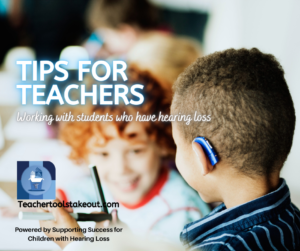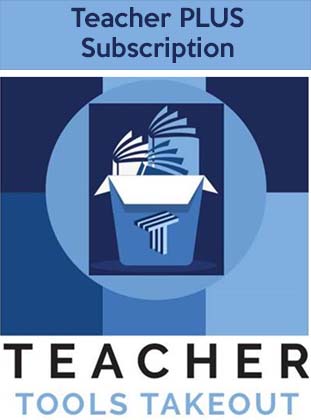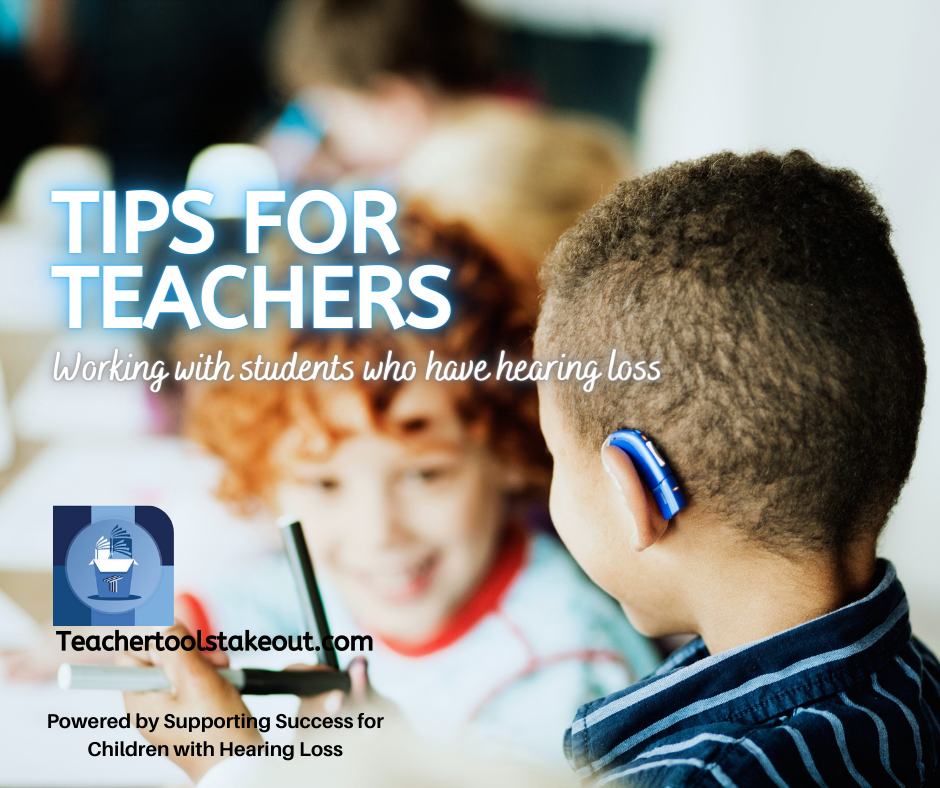Related Products
For Professionals
- Amplification
- Assessment of Student Skills, Challenges, Needs
- Early Childhood: Infants, Toddlers, Preschool
- Hearing Loss – Identification, Impact and Next Steps
- IDEA Law Summary Information
- Language and Speech Development Issues
- Legal Issues in Serving Children with Hearing Loss
- Listening (Auditory Skills) Development
- Planning to Meet Student Needs
- Self-Advocacy Skills for Students with Hearing Loss
- Self-Concept: How the Child with Hearing Loss Sees Himself
- Social Skills
- Speech Perception & Learning
Related Teacher Tools Takeout Items
Tips for Teachers Working with Students who have Hearing Loss
Ways to Help Teachers Get Up to Speed on the Needs of Their Students with Hearing Loss
 A new school year, new students on your caseload, and many teachers that need to know about the special learning needs their students with hearing loss ASAP. There is only so much time in any day, yet preparing the classroom teacher for EVERY student still needs to happen within the first week or so of school start. This article will present streamlined ways to raise awareness and understanding of classroom teachers about the challenges of learning in a busy classroom with hearing loss and how they can support their student’s success.
A new school year, new students on your caseload, and many teachers that need to know about the special learning needs their students with hearing loss ASAP. There is only so much time in any day, yet preparing the classroom teacher for EVERY student still needs to happen within the first week or so of school start. This article will present streamlined ways to raise awareness and understanding of classroom teachers about the challenges of learning in a busy classroom with hearing loss and how they can support their student’s success.
Firsts are best because they are beginnings. New shoes, the smell of new textbooks, freshly waxed floors, the mystery of a room full of new students and the challenge of so much to teach! Every classroom teacher starts the year running. Their attention is in high demand by administration, parents, student behavior, unfamiliar curriculum, and a myriad of details. And YOU, the teacher of the deaf/hard of hearing who needs a bit of their time to help them understand the special learning issues that come with having a hearing loss, and usually, using hearing devices. Below are some ideas for Inservicing with IMPACT!
Face-to-Face Inservicing
 Some itinerant teachers of the deaf/hard of hearing and educational audiologists are fortunate enough to be able to meet with the classroom teachers 1:1 and share information about the new student with hearing loss. AWESOME!
Some itinerant teachers of the deaf/hard of hearing and educational audiologists are fortunate enough to be able to meet with the classroom teachers 1:1 and share information about the new student with hearing loss. AWESOME!
- Know your ‘sound bites’! Teachers can’t remember everything. If they only took away 5 ideas from your inservice, what do you want them to be? Here are some examples (but YOU know your students best!). Come up with your own list or have a ‘group think’ with your DHH team.
- Learning issues are due to decreased communication access, not due to learning disabilities. Academic success is driven by communication access. This means accommodations are job #1.
- Lipreading and preferential seating cannot make up for not hearing all of what was said (play a bit of a fun lipreading mistake video to make this point i.e., https://www.youtube.com/watch?v=GxdaYxunZXg
- It takes more effort to learn when there are communication access issues. Students who are distracted or not following along may be taking a much needed listening (or interpreter) break.
- More of the same, is not enough. Students with hearing loss often need different teaching strategies for deep learning to occur, not more practice.
- Most kids love lunch, recess, and talking in the classroom with their friends. Students who are hard of hearing cannot process speech at the same speed, or level of comprehension when there are multiple talkers and its noisy.
- Experiences are more likely to be remembered than having hearing loss described (like the fun lipreading video). Audio or video simulations or activities can be quick to do and result in remembering why, how, when to accommodate communication access needs.
- Audio simulations Audio simulations 1 Audio simulations 2 Audio simulations 3
- Video simulations Video 1 Video 2
- Brief activities Activity 1 Activity 2
- Leave only 1-2 handouts. There IS so much you need to share, but the more paper you leave, the more likely it is the teacher will push the pile aside until ‘she has time’, which may never happen. Search for ‘inservice’ in Teacher Tools Takeout and you will have lots to choose from!
Remote Inservicing
The average caseload for an itinerant teacher of the deaf/hard of hearing is 25 students in 6-11 buildings. It is impossible to find time to talk with each teacher in the first few days of school. But you KNOW she needs to have this information! It is very unlikely that one email, text, Zoom, or call will make as much impact as a face-to-face inservice meeting. This means that you need to focus on providing information in easy-to-implement concepts over time. Repetition and practice are two things we know that support true learning!
 Tips for Teachers is unlike any product you’ve seen before! Renowned educational audiologist Jim Bombicino recorded 10 short (2 minute) videos that are intended to be shared with classroom teachers. Share each video up to 50 times. You choose which topic you want to send to whom. Simply type in the teacher email addresses, include your brief message, and send! All of the teachers will receive an email identifying you as the sender with a video link and passcode. They can watch videos twice. Best yet, you can check the video system to see who downloaded the video and when, so you know those extra busy teachers who may need more attention from you.
Tips for Teachers is unlike any product you’ve seen before! Renowned educational audiologist Jim Bombicino recorded 10 short (2 minute) videos that are intended to be shared with classroom teachers. Share each video up to 50 times. You choose which topic you want to send to whom. Simply type in the teacher email addresses, include your brief message, and send! All of the teachers will receive an email identifying you as the sender with a video link and passcode. They can watch videos twice. Best yet, you can check the video system to see who downloaded the video and when, so you know those extra busy teachers who may need more attention from you.
VIDEO ABOUT TIPS FOR TEACHERS The Tips for Teachers video topics are:
- Use and placement of the wireless microphone
- Introducing the microphone to the class
- Noise through the microphone
- Muting the microphone
- Watching videos effectively
- Connecting to media
- Small group learning sessions
- Classroom noise
- Moving around the classroom
- Facing the student
Videos include demonstration of what it is like to listen with hearing devices in the classroom. This is another way to ‘experience’ hearing loss for deeper understanding of student needs.
Included with the videos are inservice handouts and emailable tips for teachers. These are time tested handouts with simple/clear information you can send to a teacher when you introduce the student’s needs. Follow up with a weekly email tip, or as often as you feel is needed. Repeated contact from YOU is a reminder of extra knowledge and action needed from the teacher. Introducing one or two concepts at a time is most likely to be implemented unless you can drop into the classroom and see the teacher regularly.
Inservicing is a great way to start a new school year! Happy Inservicing!
Author: Karen L. Anderson, PhD
Click here to download this article


